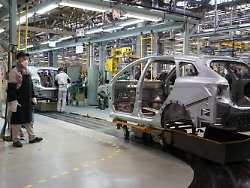“The factory is everything”
Auto-city Tolyatti suffers from sanctions
04/09/2022, 11:10 am
The Russian industrial city of Tolyatti is preparing for hard times. Production for the country’s largest car manufacturer has been going on there for decades, and the entire city is built around the factory. The current Western sanctions are hitting the industry and its employees hard.
For generations, the Russian city of Tolyatti, with its gigantic car factory, has been synonymous with the Lada manufacturer Avtovaz, the country’s largest car manufacturer. But because of the international sanctions, the city is in danger of falling into a downward spiral – and with it the workers.
In a small apartment in the checkerboard neighborhood surrounding the sprawling factory, some of these workers sit under their union’s red flags. “It’s a factory town. Everyone here works either for the factory or for the police,” says Alexander Kalinin. The 45-year-old freight elevator driver has been with the Avtovaz Group, which is majority-owned by the Renault-Nissan Alliance, for 15 years.
“For Tolyatti, the factory is everything. The whole city was built around it,” says 33-year-old Irina Miyalkina, who has worked in a spare parts warehouse for 11 years. The construction of the factory began in 1966 with the help of Fiat in the city named after the Italian communist Palmiro Togliatti.
Tolyatti rose to fame during the Soviet era, then experienced the economic crisis of the 1990s and finally a renaissance in the 2010s with the entry of Renault. With the Russian offensive in Ukraine and the international economic sanctions that followed, Tolyatti and his workers are now preparing for darker times again. “When I started, I was full of enthusiasm, I hoped for a good income. I still hope so,” says Irina with a sad smile.
But times are getting tougher at the moment: because of the sanctions, components and spare parts are no longer arriving. The workers are on paid vacation, at two-thirds of their usual wages. As a result, Irina only gets around 13,000 of her monthly 20,000 rubles – the equivalent of less than 140 euros. “The price increase is enormous and people are nervous,” says Irina, referring to the runaway inflation.
The trend was actually positive
In 2018 the future looked bright. Renault invited the press to visit its extensively renovated industrial jewel on the Volga, around 780 kilometers south-east of Moscow. The French group had brought the disused Soviet factory up to date thanks to investments running into the billions – but this also involved a reduction in staff: during the Soviet era, around 120,000 people were still employed in vehicle construction in the city of 700,000; within ten years the number was then reduced from 70,000 to 40,000.
“There were a lot of problems with employees leaving, but there was still a clearly positive trend,” says Andrei Yakovlev of the Moscow School of Economics. “A major Russian car manufacturer was in the making.”
But now this dream threatens to burst in view of the stopped assembly lines. Employees must take their three-week summer vacation in April while Renault considers exiting Avtovaz. The company itself does not want to comment; the doors of the factory remain closed to AFP this time, as do those of the Lada Museum and many suppliers. When AFP films the area around the factory, the Avtovaz security service calls the police, who take the journalists to the station and question them for several hours.
Thousands of workers are suffering
Even if there are no layoffs for the time being, many employees are already being forced to take on a second job. The 31-year-old Leonid – actually a mechanic – reports that he supplements his salary with a job in the security service to support his wife and children.
Meanwhile, in an underground car park, two men in vintage overalls are bending over the inside of a freshly painted red Lada Niva from the 80s, the legendary 4×4. “Ever since I was a child, my whole life has been linked to the factory,” says Sergej Diogrik, who runs the Lada History Club and usually brings together enthusiasts from all over the world. “My uncle came to work there in the 1970s, then my father came, then my mother and I,” he says.
“All our relatives in Tolyatti worked at the factory, and I worked there myself. I had no other choice, everything is connected to the company,” he says. Diogrik reports that the production record in the early 1980s was 720,000 cars per year – against just under 300,000 cars produced in Tolyatti in 2021.
Economic researcher Yakovlev assumes that Avtovaz will in future focus on models “whose production is completely local” and will also “contact the Chinese”. But Avtovaz and his factory town could well take a few years to reinvent themselves.
